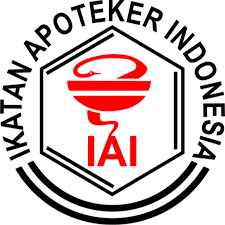Cytotoxic Assay of Semipolar Fraction Of Ethanolic Extract From Sugar Apple (Annona Squamosa L.) Stem Bark on T47D Cells
Cita Hanif Muflihah(1*), Haryoto Haryoto(2), Peni Indrayudha(3)(1) Fakultas Farmasi Universitas Muhammadiyah Surakarta
(2)
(3)
(*) Corresponding Author
Abstract
Keywords
Full Text:
PDFReferences
Chen, X. and Thibeault, S. (2013) ‘Effect of DMSO concentration, cell density and needle gauge on the viability of cryopreserved cells in three dimensional hyaluronan hydrogel’, in Proceedings of the Annual International Conference of the IEEE Engineering in Medicine and Biology Society, EMBS. NIH Public Access, pp. 6228–6231. doi: 10.1109/EMBC.2013.6610976.
Johns, T., Windust, A., Jurgens, T., & Mansor, S.M., 2011, Antimalarial alkaloids isolated from Annona squamosa, Phytopharmacology, 1(3) 49-53.
Karimi, A., Majlesi, M. and Rafieian-Kopaei, M. (2015) ‘Herbal versus synthetic drugs; beliefs and facts.’, Journal of nephropharmacology. Society of Diabetic Nephropathy Prevention, 4(1), pp. 27–30. Available at: http://www.ncbi.nlm.nih.gov/pubmed/28197471 (Accessed: 28 December 2020).
Kementrian Kesehatan RI (2018) ‘Pedoman Nasional Pelayanan Kedokteran Tata Laksana Kanker Payudara’, Keputusan Menteri Kesehatan Republik Indonesia, 2, pp. 227–249.
Kementrian Kesehatan RI (2019) Hari Kanker Sedunia 2019, https://www.kemkes.go.id/. Available at: https://www.kemkes.go.id/article/view/19020100003/hari-kanker-sedunia-2019.html (Accessed: 28 December 2020).
Markham, K.R., 1982, Cara Mengidentifikasi Flavonoid, diterjemahkan oleh Kosasih Padmawinata, Penerbit ITB, Bandung.
Meiningrum, I., 2012, Aktivitas Sitotoksik Fraksi Polar Ekstrak Etanol Daun Srikaya (Annona squamosa L.) Terhadap Sel T47D, Skripsi, Fakultas Farmasi Universitas Muhammadyah Surakarta, Surakarta.
Mondal, A. et al. (2019) ‘Alkaloids for cancer prevention and therapy: Current progress and future perspectives’, European Journal of Pharmacology. Elsevier B.V. doi: 10.1016/j.ejphar.2019.172472.
Sullivan, R. et al. (2015) ‘Global cancer surgery: Delivering safe, affordable, and timely cancer surgery’, The Lancet Oncology, 16(11), pp. 1193–1224. doi: 10.1016/S1470-2045(15)00223-5.
Pandey, Neha., & Dushyant Barve, 2011, Phytochemical and Pharmacologycal Review on Annona squamosa Linn, International Journal of Research in Pharmaceutical and Biomedical Sciences. Vol. 2(4), 1404-1412.
Pardhasaradhi, B V V., Madhurima, Reddy., Ali, A Mubarak., Kumari, A Leela., & Khar, Ashok., 2004, Antitumour activity of Annona squamosa seed extracts is through the generation of free radicals and induction of apoptosis, Indian Journal of Biochemistry & Biophysics, Vol. 41, 167-172.
Pardhasaradhi, B V V., Madhurima, Reddy., Ali, A Mubarak., Kumari, A Leela., & Khar, Ashok, 2005, Differential cytotoxic effects of Annona squamosa seed extracts on human tumour cell lines: Role of reactive oxygen species and glutathione, J. Biosci, 30 (2), 237-244.
Pisutthanan, S., Plianbangchang, P., Pisutthanan, N., Ruanruay, S., & Muanrit, O., 2004, Brine Shrimp Lethality Activity of Thai Medicinal Plants in the Family Meliaceae, Naresuan University Journal 2004, 12(2), 13-18.
Rajabalian, S., Foroumadi, A., Shafiee, A., & Emami, S., 2007, Functionalized N-(2-oxyminoethyl) Piperazinyl Quinolones as New Cytotoxic Agents, J Pharm Pharmaceut Sci, 10 (2), 153-158.
Rachmayanti, H., 2012, Aktivitas Sitotoksik Fraksi Nonpolar Ekstrak Etanol Kulit Batang Srikaya (Annona squamosa L.) Terhadap Sel T47D, Skripsi, Fakultas Farmasi Universitas Muhammadyah Surakarta, Surakarta.
Rahayu, W.Y., 2012, Aktivitas Sitotoksik Ekstrak Etanol Kulit Batang Srikaya (Annona squamosa L.) Terhadap Sel T47D, Skripsi, Fakultas Farmasi Universitas Muhammadyah Surakarta, Surakarta.
Rimbawan, Y., 2012, Aktivitas Sitotoksik Fraksi Polar Ekstrak Etanol Biji Srikaya (Annona squamosa L.) Terhadap Sel T47D, Skripsi, Fakultas Farmasi Universitas Muhammadyah Surakarta, Surakarta.
Umma, C., 2012, Aktivitas Sitotoksik Fraksi Polar Ekstrak Etanol Kulit Batang Srikaya (Annona squamosa L.) Terhadap Sel T47D, Skripsi, Fakultas Farmasi Universitas Muhammadiyah Surakarta, Surakarta.
Villo, P., 2008, Synthesis of Acetogenins Analogues, Tesis, Intitute of Technology Faculty of Science and Technology, University of Tartu.
Wagner, H., Bladt, S., & Zgainski, E. M., 1995, Plant Drug Analisys: A Thin Layer Chromatography Atlas, diterjemahkan oleh Th. A. Scott, Springer-Verlag, Berlin.
Wang, D.-S. et al. (2014) Annona squamosa Linn: cytotoxic activity found in leaf extract against human tumor cell lines - PubMed, Pak J Pharm Sci. 2014 Sep;27(5 Spec no):1559-63. doi: 25176251.
Wink, M., 2007, Molecular Modes of Action of Cytotoxic Alkaloids: From DNA Intercalation, Spindle Poisoning, Topoisomerase Inhibition to Apoptosis and Multiple Drug Resistance, The Alkaloids, Volume 64, 1-47.
Article Metrics
Abstract view(s): 512 time(s)PDF: 413 time(s)
Refbacks
- There are currently no refbacks.








